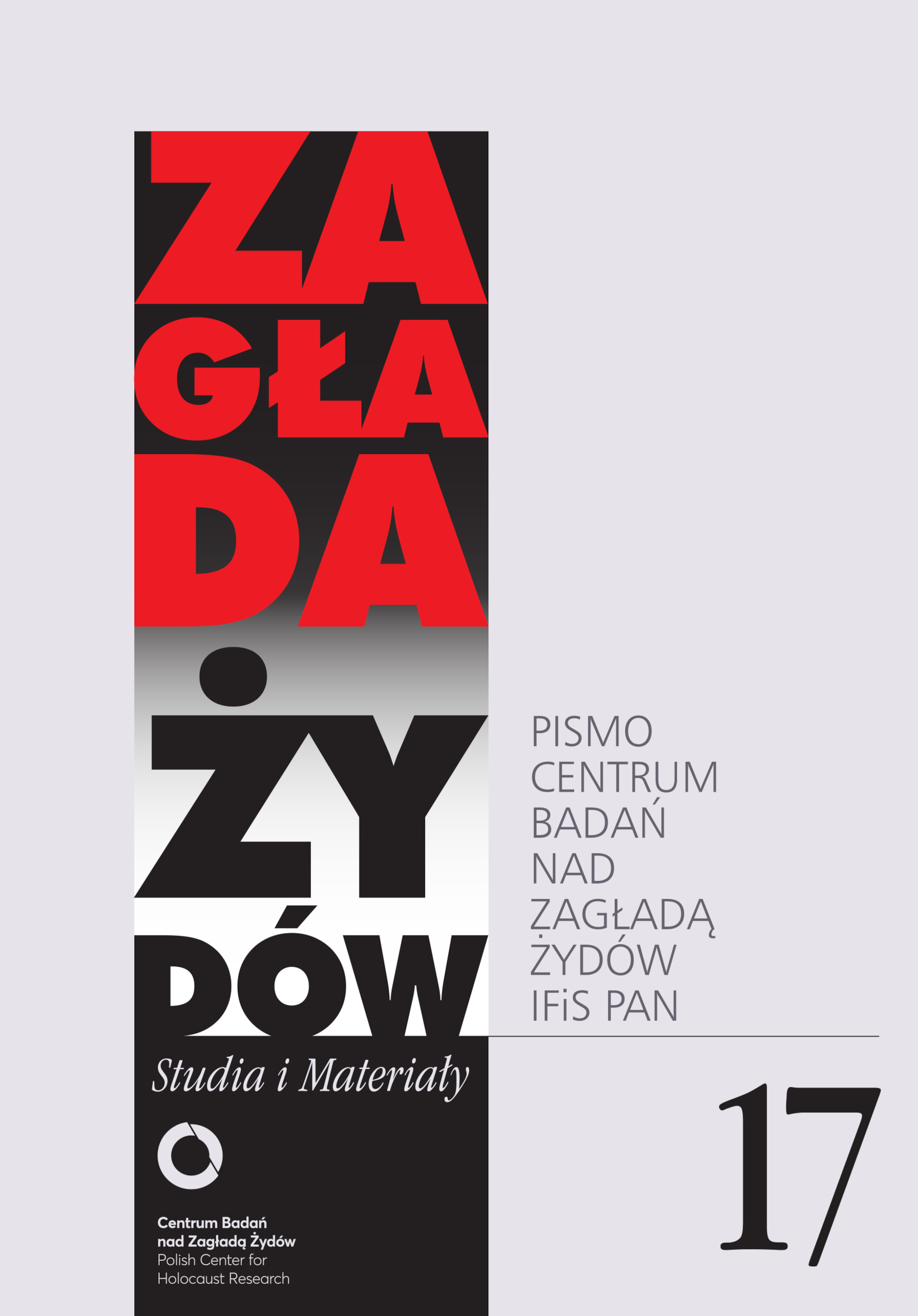When Fajga Left Tadeusz. Wartime Relationships of Survivors after the Holocaust
Zagłada Żydów. Studia i Materiały, No. 17 (2021), Pages: 229-260
Submission Date: 2021-12-17Publication Date: 2021-12-20
 https://doi.org/10.32927/zzsim.877
https://doi.org/10.32927/zzsim.877
Abstract
This article examines the post-war correspondence between Fajga Ginsburg, a Polish Jewish woman who survived the Holocaust in Lwów (today Lviv in Ukraine), and Tadeusz Kobyłko – a Pole who hid her and her niece. Their letters offer a window into intimate dilemmas in the aftermath of the war. Their relationship exemplifies decisions made by survivors with regard to their identity. Fajga’s letters express the emotional trauma of Jews who survived the Holocaust and show the lasting effects of post-war choices made by the survivors. Her letters also reveal how differently Faiga and Tadeusz understood their relationship and subsequent separation, in part due to their addressing different audiences whilst writing. While Fajga wrote personal letters to her husband, Tadeusz’s letters were sent to various Jewish and Polish institutions and were more official in nature. His letters clearly echoed his anger at the “Jews” whom he blamed for the breakdown of his family, but they are also permeated by a sense of threat of post-war antisemitism in Poland, as he himself experienced it after Fajga’s departure. Although the exchange of letters between Fajga and Tadeusz is rich and full of understatements, it refutes the stereotypes of a “nationalist Pole” and a “self-conscious Jew”. Indeed, both categories turn out to be an oversimplification that does not reflect the complexity of the relationship, especially the one initiated under the duress of the Holocaust.
Keywords
Aryan papers , sexual barter , gender , rational relationships , Righteous among the Nations
References
Źródła archiwalne / Archival sources
Google Scholar
Archiwum Yad Vashem (AYV)
Google Scholar
M.31.2/5604
Google Scholar
The Central Database of Shoah Victims’ Names, Shlomo Keller, https://yvng.yadvashem.org/nameDetails.html?language=en&itemId=3936984&ind=7
Google Scholar
Archiwum Żydowskiego Instytutu Historycznego (AŻIH)
Google Scholar
Centralna Kartoteka Żydów w Polsce 1945–1951, 303/V/425, 1755/79930
Google Scholar
/6612
Google Scholar
United States Holocaust Memorial Museum (USHMM)
Google Scholar
Itta Keller Ben-Haiem Collection, 2007.129.1
Google Scholar
Literatura przedmiotu / Content related literature
Google Scholar
Aleksiun Natalia, Dokąd dalej? Ruch syjonistyczny w Polsce 1944–1950, Warszawa: Trio, 2002.
Google Scholar
Aleksiun Natalia, Uneasy Bonds. On Jews in Hiding and the Making of Surrogate Families [w:] Jewish and Romani Families in the Holocaust and Its Aftermath, red. Eliyana R. Adler, Kateřina Čapková, New Brunswick, NJ: Rutgers University Press, 2020.
Google Scholar
Arieh J. Kochavi, The Struggle against Jewish Immigration to Palestine, „Middle Eastern Studies” 1998, t. 34, nr 3.
Google Scholar
Avinoam Patt, Finding Home and Homeland. Jewish Youth and Zionism in the Aftermath of the Holocaust, Detroit, MI: Wayne State University Press, 2009.
Google Scholar
Bikont Anna, Sendlerowa. W ukryciu, Wołowiec: Czarne, 2017.
Google Scholar
Bogner Nahum, At the Mercy of Strangers. The Rescue of Jewish Children with Assumed Identities in Poland, Jerusalem: Yad Vashem, 2009.
Google Scholar
Cichopek-Gajraj Anna, Beyond Violence. Jewish Survivors in Poland and Slovakia, 1944–1948, Cambridge: Cambridge University Press, 2014.
Google Scholar
Cohen Boaz, Survivor Caregivers and Child Survivors. Rebuilding Lives and the Home in the Postwar Period, „Holocaust and Genocide Studies” 2018, t. 32, nr 1.
Google Scholar
Engel David, The Reconstruction of Jewish Communal Institutions in Postwar Poland. The Origins of the Central Committee of Polish Jews, 1944–1945, „East European Politics and Societies” 1996, t. 10, nr 1.
Google Scholar
Friedla Katharina, „A Naye Yidishe Heym in Nidershlezye”. Polnische Shoah-Überlebende in Wrocław (1945–1949). Eine Fallstudie, „S:I.M.O.N. Shoah: Intervention. Methods. Documentation” 2014, t. 1, nr 1.
Google Scholar
Friedla Katharina, Strategie przetrwania i udzielanie pomocy żydowskim partnerom w małżeństwach mieszanych we Wrocławiu i Hamburgu. Studium kilku przypadków, „Zagłada Żydów. Studia i Materiały” 2015, nr 11.
Google Scholar
Grabowski Jan, Ratowanie Żydów za pieniądze: przemysł pomocy, „Zagłada Żydów. Studia i Materiały” 2008, nr 4.
Google Scholar
Grabowski Jan, Rescue for Money. Paid Helpers in Poland, 1939–1945, Jerusalem: Yad Vashem, 2008.
Google Scholar
Gross Jan Tomasz, Strach. Antysemityzm w Polsce tuż po wojnie. Historia moralnej zapaści, Kraków: Znak, 2008.
Google Scholar
Gusarov Katya, Sexual Barter and Jewish Women’s Efforts to Save Their Lives. Accounts from the Righteous among the Nations Archives, „German History”, 25 V 2020, https://doi.org/10.1093/gerhis/ghaa034.
Google Scholar
Hájková Anna, Sexual Barter in Times of Genocide. Negotiating the Sexual Economy of the Theresienstadt Ghetto, „Signs” 2013, t. 38, nr 3.
Google Scholar
Kamil Kijek, Aliens in the Lands of the Piasts. The Polonization of Lower Silesia and Its Jewish Community in the Years 1945–1950 [w:] Jews and Germans in Eastern Europe. Shared and Comparative Histories, red. Tobias Grill, Berlin–Boston, MA: 2018.
Google Scholar
Kaplan Marion A., Between Dignity and Despair. Jewish Life in Nazi Germany, New York–Oxford: Oxford University Press, 1998.
Google Scholar
Keller Itta Benhaiem, U-welibi homa, Jeruszalaim: Yad Vashem, 2009.
Google Scholar
Keller Itta, Stary Sambor and Lviv, Ukraine, http://missing-identity.net/itta-keller-stary-sambor-and-lviv-ukraine.
Google Scholar
Meyer Beate, „Jüdische Mischlinge”. Rassenpolitik und Verfolgungserfahrung 1933–1945, Hamburg: Dölling und Galitz Verlag, 1999.
Google Scholar
Michlic Joanna B., Piętno Zagłady. Wojenna i powojenna historia oraz pamięć żydowskich dzieci ocalałych w Polsce, Warszawa: Żydowski Instytut Historyczny, 2020.
Google Scholar
Michlic Joanna B., “The War Began for Me after the War.” Jewish Children in Poland, 1945–49 [w:] The Routledge History of the Holocaust, red. Jonathan C. Friedman, London: Routledge, 2011.
Google Scholar
Nachmany-Gafny Emunah, Dividing Hearts. The Removal of Jewish Children from Gentile Families in Poland in the Immediate Post-Holocaust Years, Jerusalem: Yad Vashem, 2009. Schrafstetter Susanna, Flucht und Versteck. Untergetauchte Juden in München. Verfolgungserfahrung und Nachkriegsalltag, Göttingen: Wallstein, 2015.
Google Scholar
Seidman Naomi, Sarah Schenirer and the Bais Yaakov Movement. A Revolution in the Name of Tradition, Liverpool: The Littman Library of Jewish Civilization, współpraca Liverpool University Press, 2019.
Google Scholar
Shlomi Hana, The Communist Caucus in the Central Committee of Jews in Poland, November 1944–February 1947, „Gal-Ed. On the History of the Jews in Poland” 1993, nr 13.
Google Scholar
Slucki David, The International Jewish Labor Bund after 1945. Toward a Global History, New Brunswick, NJ: Rutgers University Press, 2012.
Google Scholar
Szaynok Bożena, Bund i komuniści żydowscy w Polsce po 1945 r. [w:] Bund. 100 lat historii 1897–1997, red. Feliks Tych, Jürgen Hensel, Warszawa: Volumen, 2000.
Google Scholar
Szaynok Bożena, Z historią i Moskwą w tle. Polska a Izrael 1944–1968, Warszawa: IPN, 2007.
Google Scholar
Tokarska-Bakir Joanna, Pod klątwą. Społeczny portret pogromu kieleckiego, t. 1–2, Warszawa: Czarna Owca, 2018.
Google Scholar
Utz Raphael, Making Love and Make-Belief: Male Sexual Barter in Dov Freiberg’s “To Survive Sobibor”, „Autobiografia. Literatura, kultura, media” 2010, nr 1 (14).
Google Scholar
Wieczorek Paweł, „Sztuczny antysemityzm”. Antyżydowskie wystąpienia na Dolnym Śląsku w 1956 roku [w:] Przemoc antyżydowska i konteksty akcji pogromowych na ziemiach polskich w XX wieku, red. Konrad Zieliński, Kamil Kijek, Lublin: Wydawnictwo UMCS, 2016.
Google Scholar
Wywiad z rabinem Jaakowem Edelsteinem przeprowadzony przez Cwiego Jaakowwsona, 23 III 2017, http://beinenu.com/sites/default/files/alonim/176_22_23_77.pdf.
Google Scholar
License
Copyright (c) 2021 Author&"Holocaust Studies and Materials"

This work is licensed under a Creative Commons Attribution 4.0 International License.
https://creativecommons.org/licenses/by/4.0
The journal is published under the Diamond Open Access Standard, CC-BY-4.0 Deed - Attribution 4.0 International - Creative Commons
Most read articles by the same author(s)
- Natalia Aleksiun, Historiography of the Holocaust on the Polish-Jewish relations in Poland , Zagłada Żydów. Studia i Materiały: No. 1 (2005)
- Natalia Aleksiun, Melanie Hembera, Die Shoah im Distrikt Krakau Jüdisches Leben und deutsche Besatzung in Tarnów 1939–1945 , Zagłada Żydów. Studia i Materiały: No. 13 (2017)
Similar Articles
- Sharon Geva, Underground fighters, mothers and daughters. Jewish women in the Warsaw Ghetto during the uprising (April–May 1943) , Zagłada Żydów. Studia i Materiały: No. 19 (2023)
- Marta, Procedures Reversing Circumcision Performed in Warsaw During World War II. An Initial Attempt at Description , Zagłada Żydów. Studia i Materiały: No. 13 (2017)
- Arkadiusz Morawiec, Lagry w perspektywie genderowej , Zagłada Żydów. Studia i Materiały: No. 6 (2010)
- Havi Dreifuss, Secret Cities. A Few Remarks on Gunnar S. Paulsson’s Methodology , Zagłada Żydów. Studia i Materiały: No. 10 (2014)
- Zuzanna Schnepf-Kołacz , Polish Help to Jews in the Countryside during the German Occupation. A Sketch Using the Example of the Righteous among the Nations , Zagłada Żydów. Studia i Materiały: No. Holocaust Studies and Materials (2013)
- Jacek Leociak, “I don’t want people laughing at me for hiding Jews at my place . . .” The Case of Zdzisław and Halina Krzyczkowski , Zagłada Żydów. Studia i Materiały: 2010: Holocaust Studies and Materials
- Karolina Sulej, Jacek Leociak, “He Smiled at Me and Sent Kisses with His Hand”. On Dora Sztatman’s testimony , Zagłada Żydów. Studia i Materiały: No. 5 (2009)
- Jacek Leociak, I don’t want to expose myself to people’s laughter for hiding Jews in my place . . . the case of Zdzisław and Halina Krzyczkowski) , Zagłada Żydów. Studia i Materiały: No. 4 (2008)
- Barbara Engelking, Labyrinths and Tangles. The story of a Righteous among Nations , Zagłada Żydów. Studia i Materiały: No. 11 (2015)
- Marta Janczewska, The Encyclopedia of the Righteous Among the Nations: Rescuers of Jews during the Holocaust – Poland, Yad-Vashem, Jerusalem 2005 , Zagłada Żydów. Studia i Materiały: No. 1 (2005)
You may also start an advanced similarity search for this article.
 English
English
 Język Polski
Język Polski



 https://orcid.org/0000-0001-7712-4878
https://orcid.org/0000-0001-7712-4878

